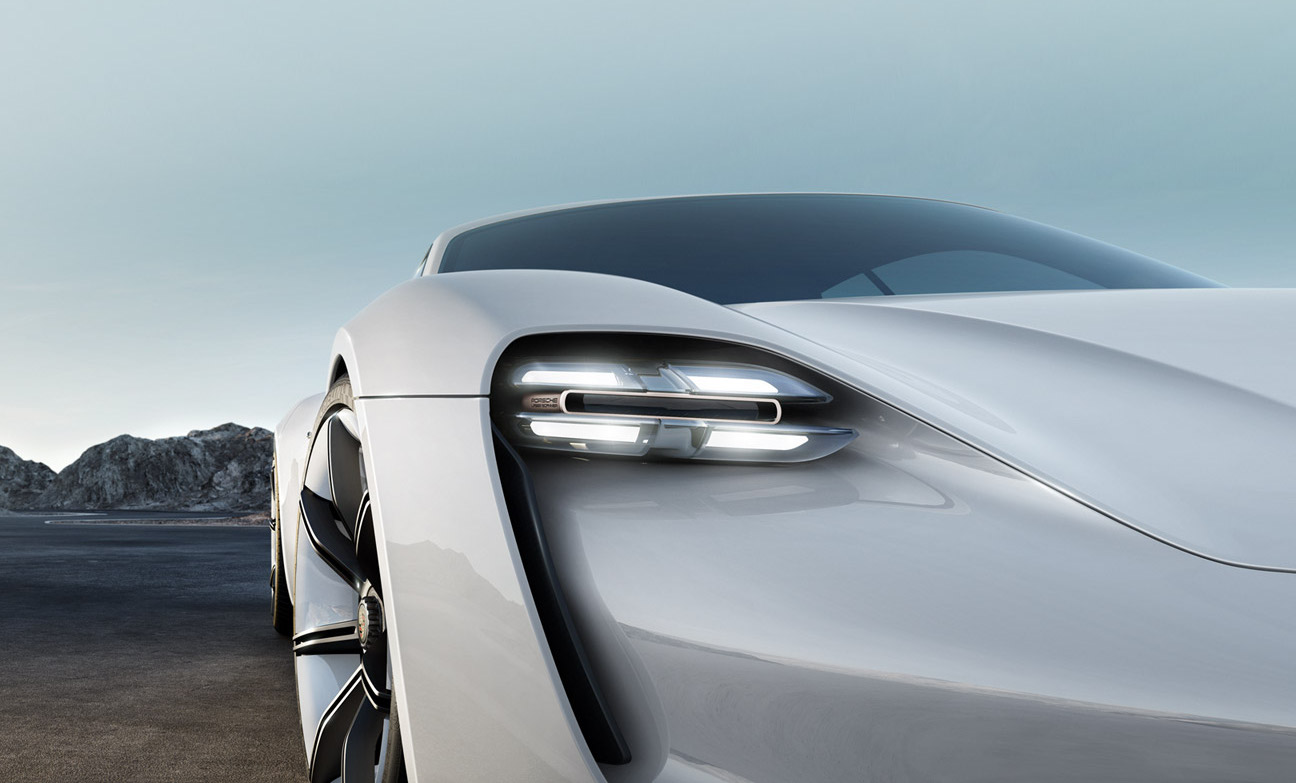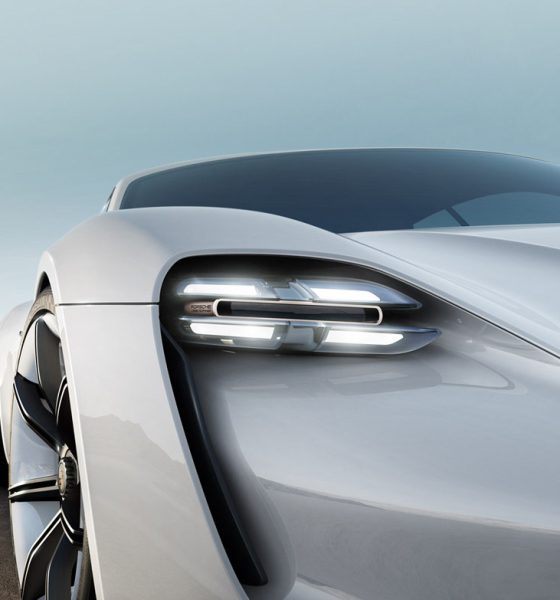

News
Porsche admits EV investment to take on Tesla is an “enormous burden”
It’s no secret that Porsche is looking to soak up market share away from Tesla when the automaker releases its long range, all-electric Mission E in 2019. Arguably one of Tesla’s strongest potential competitors, with decades of manufacturing expertise and support from parent company Volkswagen AG, the German automaker specializing in high performance vehicles is preparing to face financial headwinds as it aims to electrify its fleet.
Porsche’s CFO, Lutz Meschke, recently spoke with Automotive News Europe about the company’s plan to stay profitable as it invests billions into its electric vehicle program.
“Today Porsche packs 8,000 to 10,000 euros in added content into an electrified vehicle, but those costs cannot be passed on via the price. The customer won’t accept it, just the opposite, in some parts of the world there’s a certain hesitation,” said Meschke in his interview with Automotive News Europe.
As Porsche looks to invest more than 3 billion euros ($3.5 billion USD) into the development of EVs and plug-ins, the automaker will continue to build internal combustion engine vehicles in parallel and implement company-wide cost-cutting measures to retain its profit margin. “That’s an enormous burden for a company of our size.” says Meschke.
“To protect your margin, you have to look at substantial fixed cost cuts, but there’s only so much potential since the biggest chunks are personnel and development. As sales shift toward EVs, a temporary drop in profitability in the midterm may be expected.”
For context, Porsche’s investment into its EV program amounts to roughly 70% of what Tesla’s Gigafactory will cost when complete. It’s a massive undertaking that Porsche admits will require company restructuring along with financial incentives to its workforce. “We need to structure the company so that it is in position to sustainably achieve that. There can always be years when it might drop to below 15 percent due to exchange rates or an economic crisis, but every worker has to know we are not letting up.” says Porsche’s CFO. “There’s even a pension component.”
By setting a fixed margin target of 15% on a company-wide basis, Porsche’s entire workforce is able to work towards a single goal as looks to maintain a steady CapEx and R&D ratio. “It’s better for Porsche to work with a fixed margin target. It’s really an internal steering instrument. That’s why everyone in the company from the manager to the assembly line worker knows the goal is 15 percent. If we work with a range, that effect is diluted.”
When asked by Automotive News Europe on whether Porsche will need to implement a deep cost-cutting program to maintain the company’s high margins, Meschke responded “Under our Porsche Improvement Process, we aim for annual savings of at least 3 percent in indirect areas and 6 percent in direct ones.” Moreover, Porsche’s exec notes that the company performs a cross-department review each year to see if they were able to maintain a 10% savings. “There can always be a time when we need to pull on all levers, but identifying and extracting efficiencies is our everyday business. That way we don’t have to resort to major savings programs at the slightest headwind.”
Maximizing efficiencies across the organization is something Tesla CEO Elon Musk has long talked about. By “building the machine that builds the machine“, Tesla looks to utilize an army of manufacturing robots to achieve mass volume production of its product line that consists of vehicles, solar products and battery storage solutions. It’s the company’s key differentiator over other manufacturers that largely have robots augmenting human personnel as opposed to replacing them.
The goal to achieve full automation is Tesla’s biggest strength, yet also the company’s weakest link, as made evident when Musk announced that production of its mass market-intent Model 3 vehicle was facing issues. The downside to implementing a highly automated production line is the need to have robots that work in perfect harmony with one another. Any misconfiguration or general issue around a specific machine in the process becomes amplified across all other machines that rely on it. There’s less tolerance for errors in an automated process, explained Musk during the company’s third-quarter earnings call.
Porsche’s strategic entry into a market that’s been largely dominated by Tesla is an interesting match up that pits David versus Goliath. With two very different approaches to reaching mass volume production from two very distinct companies, it’s anyone’s guess who’ll come out ahead in the race to electric mobility. Regardless, competition helps stimulate innovation, productivity and growth prospects in the electric car sector, and that can only be a good thing.

Elon Musk
Elon Musk’s X will start using a Tesla-like software update strategy
The initiative seems designed to accelerate updates to the social media platform, while maintaining maximum transparency.

Elon Musk’s social media platform X will adopt a Tesla-esque approach to software updates for its algorithm.
The initiative seems designed to accelerate updates to the social media platform, while maintaining maximum transparency.
X’s updates to its updates
As per Musk in a post on X, the social media company will be making a new algorithm to determine what organic and advertising posts are recommended to users. These updates would then be repeated every four weeks.
“We will make the new 𝕏 algorithm, including all code used to determine what organic and advertising posts are recommended to users, open source in 7 days. This will be repeated every 4 weeks, with comprehensive developer notes, to help you understand what changed,” Musk wrote in his post.
The initiative somewhat mirrors Tesla’s over-the-air update model, where vehicle software is regularly refined and pushed to users with detailed release notes. This should allow users to better understand the details of X’s every update and foster a healthy feedback loop for the social media platform.
xAI and X
X, formerly Twitter, has been acquired by Elon Musk’s artificial intelligence startup, xAI last year. Since then, xAI has seen a rapid rise in valuation. Following the company’s the company’s upsized $20 billion Series E funding round, estimates now suggest that xAI is worth tens about $230 to $235 billion. That’s several times larger than Tesla when Elon Musk received his controversial 2018 CEO Performance Award.
As per xAI, the Series E funding round attracted a diverse group of investors, including Valor Equity Partners, Stepstone Group, Fidelity Management & Research Company, Qatar Investment Authority, MGX, and Baron Capital Group, among others. Strategic partners NVIDIA and Cisco Investments also continued support for building the world’s largest GPU clusters.
News
Tesla FSD Supervised wins MotorTrend’s Best Driver Assistance Award
The decision marks a notable reversal for the publication from prior years, with judges citing major real-world improvements that pushed Tesla’s latest FSD software ahead of every competing ADAS system.

Tesla’s Full Self-Driving (Supervised) system has been named the best driver-assistance technology on the market, earning top honors at the 2026 MotorTrend Best Tech Awards.
The decision marks a notable reversal for the publication from prior years, with judges citing major real-world improvements that pushed Tesla’s latest FSD software ahead of every competing ADAS system. And it wasn’t even close.
MotorTrend reverses course
MotorTrend awarded Tesla FSD (Supervised) its 2026 Best Tech Driver Assistance title after extensive testing of the latest v14 software. The publication acknowledged that it had previously criticized earlier versions of FSD for erratic behavior and near-miss incidents, ultimately favoring rivals such as GM’s Super Cruise in earlier evaluations.
According to MotorTrend, the newest iteration of FSD resolved many of those shortcomings. Testers said v14 showed far smoother behavior in complex urban scenarios, including unprotected left turns, traffic circles, emergency vehicles, and dense city streets. While the system still requires constant driver supervision, judges concluded that no other advanced driver-assistance system currently matches its breadth of capability.
Unlike rival systems that rely on combinations of cameras, radar, lidar, and mapped highways, Tesla’s FSD operates using a camera-only approach and is capable of driving on city streets, rural roads, and freeways. MotorTrend stated that pure utility, the ability to handle nearly all road types, ultimately separated FSD from competitors like Ford BlueCruise, GM Super Cruise, and BMW’s Highway Assistant.
High cost and high capability
MotorTrend also addressed FSD’s pricing, which remains significantly higher than rival systems. Tesla currently charges $8,000 for a one-time purchase or $99 per month for a subscription, compared with far lower upfront and subscription costs from other automakers. The publication noted that the premium is justified given FSD’s unmatched scope and continuous software evolution.
Safety remained a central focus of the evaluation. While testers reported collision-free operation over thousands of miles, they noted ongoing concerns around FSD’s configurable driving modes, including options that allow aggressive driving and speeds beyond posted limits. MotorTrend emphasized that, like all Level 2 systems, FSD still depends on a fully attentive human driver at all times.
Despite those caveats, the publication concluded that Tesla’s rapid software progress fundamentally reshaped the competitive landscape. For drivers seeking the most capable hands-on driver-assistance system available today, MotorTrend concluded Tesla FSD (Supervised) now stands alone at the top.
News
Elon Musk’s Grokipedia surges to 5.6M articles, almost 79% of English Wikipedia
The explosive growth marks a major milestone for the AI-powered online encyclopedia, which was launched by Elon Musk’s xAI just months ago.

Elon Musk’s Grokipedia has grown to an impressive 5,615,201 articles as of today, closing in on 79% of the English Wikipedia’s current total of 7,119,376 articles.
The explosive growth marks a major milestone for the AI-powered online encyclopedia, which was launched by Elon Musk’s xAI just months ago. Needless to say, it would only be a matter of time before Grokipedia exceeds English Wikipedia in sheer volume.
Grokipedia’s rapid growth
xAI’s vision for Grokipedia emphasizes neutrality, while Grok’s reasoning capabilities allow for fast drafting and fact-checking. When Elon Musk announced the initiative in late September 2025, he noted that Grokipedia would be an improvement to Wikipedia because it would be designed to avoid bias.
At the time, Musk noted that Grokipedia “is a necessary step towards the xAI goal of understanding the Universe.”
Grokipedia was launched in late October, and while xAI was careful to list it only as Version 0.1 at the time, the online encyclopedia immediately earned praise. Wikipedia co-founder Larry Sanger highlighted the project’s innovative approach, noting how it leverages AI to fill knowledge gaps and enable rapid updates. Netizens also observed how Grokipedia tends to present articles in a more objective manner compared to Wikipedia, which is edited by humans.
Elon Musk’s ambitious plans
With 5,615,201 total articles, Grokipedia has now grown to almost 79% of English Wikipedia’s article base. This is incredibly quick, though Grokipedia remains text-only for now. xAI, for its part, has now updated the online encyclopedia’s iteration to v0.2.
Elon Musk has shared bold ideas for Grokipedia, including sending a record of the entire knowledge base to space as part of xAI’s mission to preserve and expand human understanding. At some point, Musk stated that Grokipedia will be renamed to Encyclopedia Galactica, and it will be sent to the cosmos.
“When Grokipedia is good enough (long way to go), we will change the name to Encyclopedia Galactica. It will be an open source distillation of all knowledge, including audio, images and video. Join xAI to help build the sci-fi version of the Library of Alexandria!” Musk wrote, adding in a later post that “Copies will be etched in stone and sent to the Moon, Mars and beyond. This time, it will not be lost.”









